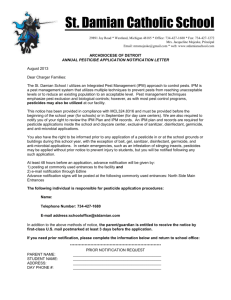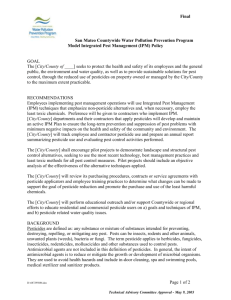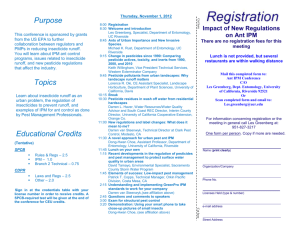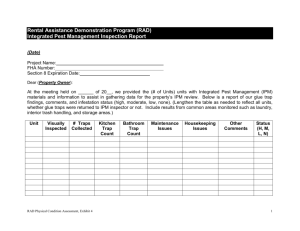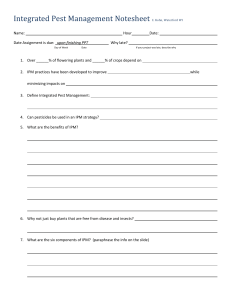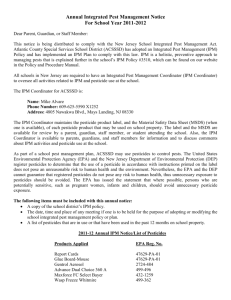sample RFP for pest control
advertisement
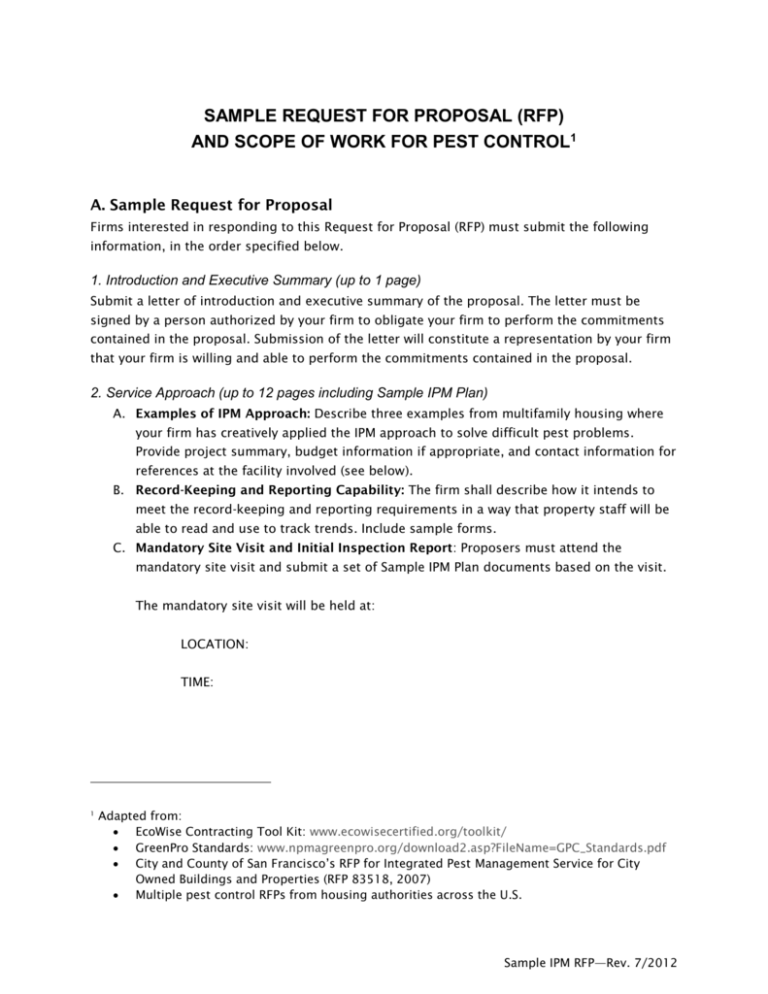
SAMPLE REQUEST FOR PROPOSAL (RFP) AND SCOPE OF WORK FOR PEST CONTROL1 A. Sample Request for Proposal Firms interested in responding to this Request for Proposal (RFP) must submit the following information, in the order specified below. 1. Introduction and Executive Summary (up to 1 page) Submit a letter of introduction and executive summary of the proposal. The letter must be signed by a person authorized by your firm to obligate your firm to perform the commitments contained in the proposal. Submission of the letter will constitute a representation by your firm that your firm is willing and able to perform the commitments contained in the proposal. 2. Service Approach (up to 12 pages including Sample IPM Plan) A. Examples of IPM Approach: Describe three examples from multifamily housing where your firm has creatively applied the IPM approach to solve difficult pest problems. Provide project summary, budget information if appropriate, and contact information for references at the facility involved (see below). B. Record-Keeping and Reporting Capability: The firm shall describe how it intends to meet the record-keeping and reporting requirements in a way that property staff will be able to read and use to track trends. Include sample forms. C. Mandatory Site Visit and Initial Inspection Report: Proposers must attend the mandatory site visit and submit a set of Sample IPM Plan documents based on the visit. The mandatory site visit will be held at: LOCATION: TIME: 1 Adapted from: EcoWise Contracting Tool Kit: www.ecowisecertified.org/toolkit/ GreenPro Standards: www.npmagreenpro.org/download2.asp?FileName=GPC_Standards.pdf City and County of San Francisco’s RFP for Integrated Pest Management Service for City Owned Buildings and Properties (RFP 83518, 2007) Multiple pest control RFPs from housing authorities across the U.S. Sample IPM RFP—Rev. 7/2012 Based on this visit, the contractor shall submit an initial site inspection report. The following specific points should be addressed in the report: Discussions of effectiveness of previous efforts; Identification of problem areas in and around the building (locations and extents of infestations, observed damage to structure or commodities, conditions conducive to infestation, harborage areas, sanitation deficiencies, avenues of potential entry); Contractor access system and coordination to all necessary areas; Information given to the contractor during the inspection about any restrictions or special safety precautions; and Any other items or factors that would impact the development of a pest management program. D. Emergency and Special Services Capability: The firm shall describe its plan for meeting the emergency and special service requests described in the scope of work (for example, availability of trucks and personnel). E. Public Health Vector Control Capability: The firm shall describe all relevant experience with control of mosquitoes and other disease vectoring organisms of public health interest. F. A Sample IPM Plan: See the Scope of Work for details. 3. Firm Qualifications (up to 3 pages) Provide the following: A. Name, address, and telephone number of a primary contact person. B. A brief description of your firm, certifications held, professional organization affiliations, as well as how any joint venture association would be structured. C. Address(es) and location(s) of local offices and service headquarters that would be involved in servicing the PHA contract. D. Description of microscopes, pest detection equipment or other equipment possessed by the firm that would be used for performance of the contract. E. Names of all staff, supervisors, and subcontractors who would work on the contract. The firm must have sufficient licensed employees to cover the property’s needs. Provide The role each staff member and subcontractor would play in the project (onsite service technician, onsite supervisor, manager, owner, etc.). Experience, education, and qualifications of each staff member, including licenses and certifications held, verification that license(s) are valid, and other relevant training or skills. Contractor shall have access to an Associate Certified Entomologist (ACE) or Board Certified Entomologist (BCE) or person holding a degree in entomology who has demonstrated expertise in structural pest control, especially for rodents, bed bugs, and cockroaches. Written assurance that the staff members listed above will be performing the work and will not be substituted with other personnel or reassigned to another project Sample IPM RFP—Rev. 7/2012 without prior approval. Assurance must also be made that any substitute personnel be fully qualified. F. Certifications: The contractor shall provide the following: Certificate of Contractor General Liability Insurance, with the contracting party named as an additional insured Certificate of Workers' Compensation Insurance A copy of the pesticide applicators’ license(s) Listing of any violations of state pesticide regulations or pest management regulations within the past three years. Description of in-house training program for firm employees. Description of in-house health & safety program. G. Commitments: The contractor must commit to providing qualified, professional pest management personnel who: Will not distribute or sell pesticide products to residents or staff; Will not store any pesticide product in the buildings specified in this contract; Understand current practices in this field and have experience providing pest control services in a residential environment; Conduct themselves in a professional manner, with minimal noise and disruption; Cooperate with the building occupants to assure the progress of this work; Have good communication skills and will speak with residents who are present during a visit. It is expected that the PMPs will make an effort to obtain pest sighting information from residents and educate them on IPM techniques; Maintain certification as a Commercial Pesticide Applicators in the category of residential and institutional pest control services; Wear a distinctive uniform that has the contractor's name easily identifiable, affixed in a permanent or semi-permanent manner while working at PHA-owned or leased properties; Use additional personal protective equipment required for safe performance of work as determined and provided by the contractor that, at a minimum, conform to Occupational Safety and Health Administration (OSHA) standards for products being used; Use only contractor vehicles identified in accordance with state and local regulations; Observe all safety precautions throughout the performance of this contract. Certain areas within some buildings may require special instructions for persons entering these areas; Will comply with all government regulations as are applicable during the time spent on government property; Obtain building passes, if needed, as supplied by the PHA or appropriate building manager; and Take all necessary precautions to ensure tenant and employee safety, and all necessary steps to ensure the containment of the pesticide to the site of application. Sample IPM RFP—Rev. 7/2012 4. References (1 page) The Contractor must submit a list of at least four (4) verifiable references (including names, titles, affiliations, and telephone numbers) for work comparable to that discussed in these specifications that has been completed during the past three (3) years or is currently in progress. 5. Price Proposal (1 page per section) The PHA intends to award this contract to the firm that it considers will provide the best overall program services. The PHA reserves the right to accept other than the lowest bid and to reject any proposals that are not responsive to this request. Please provide a price proposal in a sealed envelope that includes hourly rates for the services described in the Scope of Work. These rates will be used either to charge for services on a time and materials basis, or as base rates for negotiating flat monthly fees with individual facility managers. Focus Units Unit Turnover Service Routine Inspection Call-Back Service: No Charge Emergency Services Special Services Training/Consultation B. Scope of Work 1. Monitoring. Begin with a property-wide inspection and monitoring, using both monitoring devices and visual inspection. 2. IPM Plan. Use the monitoring results to design an IPM plan for the property. This plan will be updated at least annually along with monitoring results. The following components should be included in all written IPM plans: A. Management objectives: Identify key pests to be controlled, level of control desired (thresholds), and areas of the facility requiring special attention. Include a clear understanding of all guarantees, exclusions, and limitations, including the definitions of high-, medium-, and low infestations. Proposal must adhere to HUD’s Guidance on IPM (PIH Notice 2011-22). B. Communication and accountability system: Designate contact people and alternates at both the facility and the contractor’s company. Establish a location for the pest activity log book(s) at the facility. Set up a procedure for the contractor to report maintenance or pest prevention needs to appropriate staff at the facility. C. Schedule of service: Describe the expected schedule and duration of service visits required to meet management objectives. Except as otherwise agreed upon, all work at properties under this contract should be performed between 9:00 a.m. and 4:00 p.m., Monday through Friday, and should not interfere with daily PHA operations. Sample IPM RFP—Rev. 7/2012 D. Monitoring program: The contractor should describe methods and procedures to be used for a) identifying sites of pest harborage and access; and b) assessing pest populations throughout the term of the contract. This information must include general locations of common area monitoring traps and responsibilities for routinely checking the traps. Differences in pest pressures associated with seasons and preventative action should be addressed. As a general rule, pesticides should not be applied unless monitoring indicates the presence of pests in that specific area. E. Description of IPM methods and products: Summarize nonchemical IPM methods proposed and choose pest management strategies that are: o Least disruptive of natural controls; o Least hazardous to human health; o Least toxic to nontarget organisms; o Least damaging to the environment; o Most likely to produce a permanent reduction of the pest population; o Easiest to carry out effectively; and o Most cost-effective over the short and long-term. Do not apply pesticides inside or outside unless visual inspection or a monitoring device indicates the presence of pests in that specific area; Control rodents inside buildings only with trapping devices. All such devices shall be concealed from view, being placed in protected areas unaffected by routine cleaning and other operations. Check trapping devices on a schedule approved by the Contract Manager. The Contractor is responsible for disposing of all trapped rodents and all rodent carcasses in an appropriate manner; Use portable vacuums rather than pesticide sprays for initial cleanouts of cockroach infestations, for swarming (winged) ants and termites, and for control of spiders in webs; Bait formulations shall be the standard pesticide technology for cockroach and ant control, with alternate formulations restricted to unique situations where baits are not practical; and The Contractor shall apply all insecticides as “crack and crevice” treatments only, defined in this contract as treatments in which the formulated insecticide is not visible to a bystander during or after the application process. List EPA-approved pesticide products proposed for use in the program together with the rationale, proposed methods of use, and methods planned to minimize exposure. For each pesticide, list the product name, EPA registration number, pests targeted, and where pesticide will be applied (e.g., indoors, in wall voids, or outside). F. Desirable structural or operational changes: Identify pest-proofing activities or modification of staff operational methods or timing that would improve pest management efforts (e.g., caulking around pipes). Sample IPM RFP—Rev. 7/2012 G. Record-keeping system: Describe data to be collected and provide a sample monitoring form designed to track data on pest location, populations, harborage, trends in pest populations, status of previously suggested pest exclusion and prevention measures for which facility staff are responsible, and other relevant information. See “Log Book” below. H. Education and training activities: List recommended education and training activities for facility staff that would increase their support for IPM activities. 3. Service Units. Treatments should be scaled to the type and level of infestation and priced accordingly. A. Focus units: Units that are infested (henceforth referred to as Focus Units) shall be serviced at least monthly until the infestation is gone. Once pest-free, the focus unit will be removed from the monthly service list and inspected routinely. B. Unit turnover service: Conduct intensive inspection and necessary treatment as requested by the PHA when units are prepared for occupancy. Typically these units will be existing units changing residents. They may also be new units added to the scope of the contract. A unit is treated at unit turnover only if evidence of pest infestation is found. C. Routine inspection: Conduct regularly scheduled inspections for pests, set out or collect monitoring traps, and treat units for pests as needed. Sticky trap monitors shall be placed in all common areas and checked/replaced at each routine service. Schedule routine inspections so that the Contractor visits each unit twice a year, using the same PMPs when possible. D. Call-back service: Conduct follow-up inspection in response to resident or staff complaints. Routine call-back service shall be furnished within one (1) workday after receipt of notification by the PHA. Call-back service required by the PHA due to contractor negligence will be at no charge. E. Emergency services are directed at urgent pest problems that must be addressed as soon as is practical. They are not “call backs” resulting from other routine services provided under the contract. Except for holidays or other “shut down” periods, the Contractor is expected to address emergency problems within 24 hours of the service call. The Contractor may charge the “emergency rate” for these services but must notify the requesting department that the emergency rate applies before performing the service. In the event that such services cannot be completed within the above-stipulated time frame, the Contractor shall immediately notify the PHA representative and indicate an anticipated completion date. F. Special services are those that require special skills, training, or licensing, and may utilize subcontractors for whose work the Contractor shall be accountable. The contractor should list pests or situations for which a subcontractor will be hired. G. Regardless of service type, at each visit, the PMP must complete and leave a service ticket detailing what was found and done in each unit and area. When needed or appropriate, the Contractor shall also provide detailed, site-specific Sample IPM RFP—Rev. 7/2012 recommendations for structural and procedural modifications to aid in pest prevention. H. The Contractor shall provide additional consultation, training, and technical support, by phone or in person during business hours (8:00 a.m.–5:00 p.m.). The Contractor must provide, free of charge, up to eight (8) hours of his/her time per calendar year. C. Log Book The Contractor shall be responsible for maintaining a complete and accurate Pest Management Log Book at each facility that is served under the contract. The Log Book shall be updated at each visit by the Contractor. If the facility lacks a log book, the Contractor is responsible for providing one. The Log Book shall contain at minimum the following items: A copy of the IPM plan and/or service schedule for the building. A copy of each license, certification, or proof of insurance required. A list of pesticides used, including copies of sample labels and material safety data sheets (MSDS). All pest control products must be registered by the U.S. EPA for residential use and must be applied according to the manufacturer's label instructions and in compliance with all applicable local, state and federal laws and regulations. A pest sighting log where new work orders and a Focus Unit list is updated. The location of all traps and bait stations on the premises, preferably in map format. Copies of all service report forms for the facility. Sample educational materials for residents (with translations) D. Reporting and Recordkeeping As part of the services provided under this contract, the collection and transmittal of data collected by the contractor during the work is crucial to the effectiveness in managing the IPM. The Contractor must propose reporting and recordkeeping plans to enable the PHA to monitor Contractor’s work in a timely and efficient manner. The reporting and recordkeeping forms will be kept in the building’s IPM Log. At a minimum, Contractor is required to collect and submit the reports detailed below. The PHA will review and approve the report format prior to finalizing a contract. Notification of Upcoming Service (at least one week before scheduled visit): The Contractor shall provide Pesticide Use Notification signs and preparation instructions for the PHA to post at least one week in advance of routine inspection. The notifications will include a translation if the building residents do not speak English. Notification of Pesticide Use (at time of treatment): If an infestation is found that requires pesticides, a form is left at the treatment location detailing what product was used, where, any precautions that can be taken to reduce risk of exposure, and nonchemical control techniques that can be used to prevent further infestation. Sample IPM RFP—Rev. 7/2012 Inspection/Sanitation Report (service tickets): Upon completion of each routine inspection at the property, the Contractor must submit a summary highlighting troubled areas or units. The Contractor must submit the report in hard-copy format. The hard copy must be signed by the building manager and kept in the IPM Log. An individual Unit Service Ticket must be completed for each unit in which pesticides were applied. Quality Control Summary (bi-annually): A report on the quality control program in place that quantitatively and qualitatively measures the successes and failures of the program. A report on the findings of quality control shall include recommendations for improvement including, but not be limited to the following: o Brief narrative discussing the findings as they relate to an increase or new infestations by unit or apartment number, including recommendation for treatment or preventative measures; and o Discussion of any findings of deficiencies due to lack of access, inadequate or improper treatments, or recommendations of change to a more effective chemical. Updates to IPM Plan: Contractor shall receive the concurrence of the PHA prior to implementing any subsequent changes to the approved IPM Plan, including additional or replacement pesticides and on-site service personnel. Contractor shall continue to provide licenses for every contractor employee who will be performing on-site services before the employee begins work on the PHA’s property. Any substitutions, additions, or replacement of personnel from those cited in the contractor's original proposal must be submitted to the PHA for approval. E. Selection Criteria (600 points possible) Proposals passing the minimum requirements above will be evaluated by a selection committee that includes parties with expertise in IPM. A. Submission Requirements (10 points) Organization of the document (3 points). Complete and accurate information (4 points). Follow RFP instructions (3 points). B. Contractor’s Licenses and Certifications (70 points) Breadth and level of licenses and certifications held by Contractor’s assigned project staff and subcontractors, above and beyond the minimum requirements set by the state (10 points). Firms that offer GreenPro, GreenShield, or EcoWise service will automatically receive 30 points (30 points). Firm includes at least one onsite staff member with valid certifications for public health pest control (20 pts) Firm includes at least one onsite staff member with valid license for animal trapping (10 pts) Sample IPM RFP—Rev. 7/2012 C. Experience of Contractor and Contractor’s Assigned Project Staff (50 points) Quality of performance on recent contracts, including number of violations (30 points). Extent of experience with vector control projects (10 points). Quality and extent of in-house IPM training program (5 points). Quality and extent of in-house health & safety program (5 points). D. Service Approach (170 points) Creativity and thoroughness in seeking less-toxic pest management approaches (40 points). Emergency and special services capability (5 points). Completeness of data reporting capabilities, and abilities to integrate with the PHAs work order system (10 points). Proximity of Contractor’s business to service areas (5 points). Adequacy of Contractor’s facilities, including the availability of microscopes and other pest identification tools (5 points). Site-Specific Sample IPM Plan (95 points) o Ability of Contractor to recognize pest problems and sources of problems (30 points). o Thoroughness of recommendations for pest prevention (30 points). o Quality of recommendations for most affordable and feasible chemical or nonchemical controls (25 points). o Justification for all actions proposed (10 points). Quality and completeness of monitoring forms (5 points). Quality and completeness of service report form (5 points). E. References (100 points) Quality of recently completed projects, including effectiveness, adherence to IPM principles, adherence to schedules and budgets, and references (100 points). F. Oral Interview (100 points) Interviews conducted for up to three highest scoring proposals Contractor’s working knowledge of the biology and behavior of problem pests (15 points). Contractor’s working knowledge of the use of least toxic approaches to pest management (20 points). Extent of Contractor’s experience using nonchemical and reduced-risk chemical pest control methods (15 points). Contractor’s working knowledge of pesticide hazards, including toxicity, human exposure potential, and potential environment effects of pesticides (10 points). Knowledge of the specialized pest management concerns typically faced by PHAs (25 points). Quality of proposed communication approach between pest management personnel and PHA staff (15 points). Sample IPM RFP—Rev. 7/2012 G. Fee Proposal (100 points): Points will be awarded for each service type proportionally based on the formula below. Points for each service type will then be added together for a possible 100 points total. Formula for calculating Point Score: Points for proposer “A” for each service type = Possible points for service × (lowest qualified price proposal for service ÷ proposer “A’s” price proposal for service) Example: Firm A’s price proposal for Emergency Services: $100/hour Lowest qualified price proposal for Emergency Services: $50/hour 3 (possible points) × ($50/$100) = 1.5 points Total points for proposer “A” = Focus Unit Service Points + Unit Turnover Service Points + Routine Inspection Points + Emergency Service Points + Special Service Points + Training & Consultation Points The possible points for the various services are as follows: Service Type Possible Points Focus Unit Services 30 Unit Turnover Service 20 Routine Inspection 30 Emergency Services Special Services Training & Consultation 3 15 2 Sample IPM RFP—Rev. 7/2012 F. Evaluation Worksheet EVALUATION WORKSHEET—FOR COMPLETION BY REVIEWERS (See Evaluation & Selection Criteria for Reference) [TEMPLATE] Proposer #: Contractor Name: Reviewer: MINIMUM REQUIREMENTS Item Check 1. Registered structural pest control company 2. One onsite supervisor with Operator’s License 3. All onsite staff have Applicator certification 4. 5 years minimum experience 5. Four (4) verifiable references provided 6. All onsite supervisors have licenses Minimum Requirements Met? (If ‘No’, Stop Here) Yes No SELECTION CRITERIA Item 1. Submission Requirements (10 points) a) Organization of the document b) Complete and accurate information c) Follow RFP instructions 2. Licenses and Certification (70 points) a) Breadth and level of licenses and certifications held b) GreenPro, EcoWise or GreenShield Certified IPM Services c) Firm includes at least one onsite staff member with valid certifications for public health pest control d) Firm includes at least one onsite staff member with valid license for animal trapping 3. Experience (50 points) a) Performance on recent contracts b) Experience with vector control c) Quality and extent of in-house IPM training program d) Quality and extent of in-house health & safety program Points (3 pts) (4 pts) (3 pts) (10 pts) (30 pts) (20 pts) (10 pts) (30 pts) (10 pts) (5 pts) (5 pts) Sample IPM RFP—Rev. 7/2012 Item (cont’d) Points 4. Service Approach (170 points) a) Least toxic approach—or certified through GreenPro, GreenShield, or EcoWise: automatic 40 pts b) Emergency and special services capability c) Data reporting capabilities d) Proximity of Contractor’s business to service areas e) Adequacy of facilities, availability of microscopes, etc. f) Ability to recognize pest problems (sample IPM plan) g) Thoroughness of recommendations for pest prevention (sample IPM plan and initial inspection report) h) Quality of recommendations for most affordable and feasible chemical or non-chemical controls (sample IPM plan) i) Justification for all actions proposed (sample IPM plan) j) Quality and completeness of monitoring forms k) Quality and completeness of service report form (40 pts) (5 pts) (10 pts) (5 pts) (5 pts) (30 pts) (30 pts) (25 pts) (10 pts) (5 pts) (5 pts) 5. References (100 points) Quality of recently completed projects, including effectiveness, adherence to IPM principles, adherence to schedules and budgets, and references (100 points). 6. Oral Interview (100 points) Interviews conducted for up to three highest scoring proposals a) Knowledge of the biology and pest behavior (15 pts) b) Knowledge of least toxic pest management approaches (20 pts) c) Experience using reduced-risk chemical methods (15 pts) d) Knowledge of pesticide hazards (10 pts) e) Knowledge of the specialized pest management concerns typically faced by local government agencies (25 pts) f) Quality of proposed communication approach between Contractor’s personnel and PHA staff (15 pts) 7. Fee Proposal (100 points possible) a) Focus Unit Services: 30 × (Lowest bid $ / man-hr) / ($ / man-hr bid) = b) Unit Turnover Service: 20 × (Lowest bid $ / man-hr) / ($ / man-hr bid) = c) Routine Inspection Services: 30 × (Lowest bid $ / man-hr) / ($ / man-hr bid) = d) Emergency Services: 3 × (Lowest bid $ / man-hr) / ($ / man-hr bid) = e) Special Services: 15 × (Lowest bid $ / man-hr) / ($ / man-hr bid) = f) Consultation/Training Services: 2 × (Lowest bid $ / man-hr) / ($ / man-hr bid) = Point Score = Sum of a–f (100 points possible) Total Score (600 points) ADJUSTED FINAL SCORE Sample IPM RFP—Rev. 7/2012

